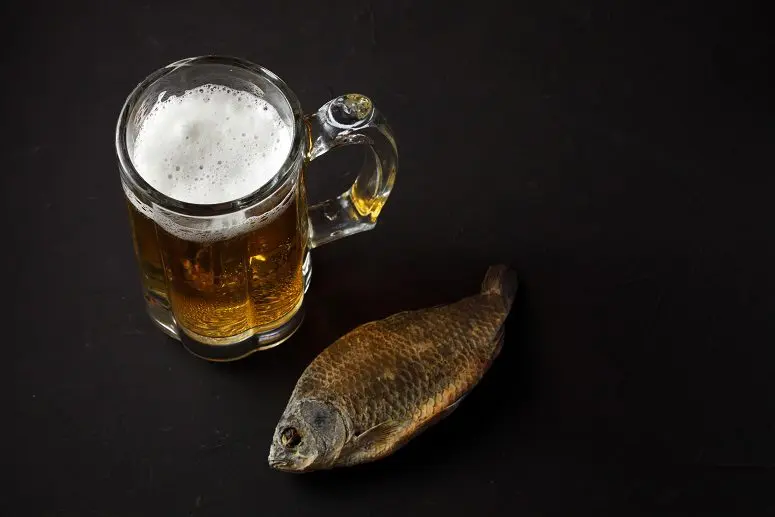A beer ram is loved not only by avid fishermen, but also by many lovers of a foamy drink who have never held a fishing rod in their hands. We bring to your attention a step-by-step methodology on how to make a ram at home, which goes perfectly with beer: it has an excellent taste and aroma, contains the right amount of fat (not too dry), moderately salted, well stored without losing properties.
Theory
Any freshwater fish is suitable for making a ram: crucian carp, roach, bream, roach, pike, sabrefish, ram, rudd, ruff, perch, gudgeon and other species. For beer, crucian carp, bream, perch and roach are often used. It is better to take small and medium fish (250-900 grams), as it salts well and does not deteriorate for a long time. Bream is considered the fattest, and ruff has few bones and very tender pulp that literally melts in your mouth. Taranka from perch is sweetish, from pike – slightly tart and piquant. Crucian carp is the golden mean in every respect. It is preferable to make a ram from fresh, still live fish. To do this, it is desirable to transport the catch in wicker baskets, and shift the fish with nettle leaves.
There are two ways to salt a ram: dry and wet. The wet method is easier, but only suitable for small fish weighing up to 400-500 grams and often worsens the flavor. Therefore, experienced fishermen salt the ram in a dry way.
Coarsely ground rock salt without impurities and additives is required, as it draws moisture well and does not saturate the meat with third-party odors. Iodized is not suitable!
You can salt fish for ramming in enameled dishes, as well as in glass or food grade stainless steel containers, since these materials are not corroded by salt and do not affect the taste of homemade ramming.
Ingredients:
- fish – 1 kg;
- kitchen rock salt – 250-300 grams.
Ram Recipe
How to salt a ram
1. Clean the fish from the insides. Leave the scales.
It is not necessary to clean carcasses weighing up to 1 kg, since the quiches will dry out, but it is still better to gut even small fish, because in summer it feeds on greens and microorganisms that give an unpleasant odor, and the finished ram has a bitter taste.
If it is still decided to leave the insides, then 10-30 ml of a saturated saline solution (1 part of water to 2-3 parts of salt) should be poured into the throat of each still living fish, when the fish swallows the brine, the internal organs are well salted.
2. Rinse each fish thoroughly in running water from the remnants of the insides. Pay special attention to areas near the head and tail.
3. Cover the bottom of the salting container with a uniform layer of salt of 1 cm.
4. Salt the gills in each fish, rub the inside with salt, then make one puncture on each side with a fork and rub the carcass well on top. The gills must be literally tamped with salt or removed altogether so that the ram is guaranteed not to deteriorate.
5. Lay the salted fish in layers one at a time. To each other, fold the carcasses back to the abdomen and head to the tail. Cover each layer with a layer of salt approximately 1 cm thick.
For better salting, it is better to lay large fish down, and small fish on top. In one layer there should be a fish of approximately the same size.

6. Place a piece of cardboard or a wooden board with holes on top of the fish. To cover round containers, you can use old lids of a smaller diameter. Holes are necessary for air access. Put a weight of 10-20 kg on top of the lid. For uniform salting, it is advisable to first put a weight of 5-10 kg, and after 6-8 hours add another 5-10 kg.
7. Move the container with the salted ram to a dark, cool place: refrigerator, cellar or basement. It is important that the fish is not exposed to direct sunlight. Can be covered with gauze to protect against insects.
The duration of salting the ram depends on the weight of the fish:
- up to 100 grams – 1-2 days;
- 600-800 grams – 3-4 days;
- from 800 grams – 5-14 days.
During the aging process, juice will be released, which must be drained every 8-12 hours. The ram is considered ready for drying when the juice is no longer released or its minimum amount.
8. Rinse each carcass in running water (especially the gills and middle), soak for 2 hours in cold water, removing excess salt. Then soak the ram for another 60 minutes in a vinegar solution (50 ml of 9% vinegar per 10 liters of water) to kill pathogens, repel flies and other insects during drying.
Among experienced fishermen there is a rule: how many days the fish was salted, so many hours should the soaking in the water last. This recommendation can be followed, but it is better not to skip the stage with the vinegar solution.
Drying home ram
9. Drain the water. For each carcass, prepare 10-15 cm of rope. In the tails, make a through puncture with an awl or a needle. Push the rope through the hole, pull it out from the back and tie a knot to make a loop. In the abdomens of large gutted fish, 1-2 “spacers” can be made from toothpicks to better dry the inside.

It is correct to dry the ram upside down so that the bitterness from the gills does not pass into the meat.
10. Hang each fish by loops to hooks (make any of the wire) on a rope. The first 2-3 hours, the knitting can be kept in one bundle, substituting a container under it to drain the remaining brine.
11. When the liquid stops dripping, move the ram to dry on a balcony or other well-ventilated place with high temperature, where there are no flies. Place the carcasses at a distance of at least 5-7 cm from each other.
The more heat and sun, the faster the carcasses dry out. After 2-4 days, you will get dried fish, and completely dry ram will become in 10-14 days.
How to store a ram
12. Ready, well-dried ram is stored for up to 4 months in cans with a tight-fitting lid or wrapped in parchment. The shelf life of dried fish is half that. Optimal storage conditions: temperature +3-8 °C, air humidity – 80%, no direct sunlight.
Cellophane bags should not be used for storage, because due to the lack of air, the fish will quickly deteriorate.
An overdried homemade ram can be brought to condition by wrapping it with damp, but not wet paper, and leaving it for 1-2 days.










